Vestis Retail Group Bundle
What Defined Vestis Retail Group's Customer Base?
In the ever-evolving world of retail, understanding your customer is paramount. For Vestis Retail Group, grasping the nuances of their Vestis Retail Group SWOT Analysis, customer demographics and target market was crucial for navigating a turbulent market. This analysis isn't just about numbers; it's about understanding the heart of their business and the people they aimed to serve.
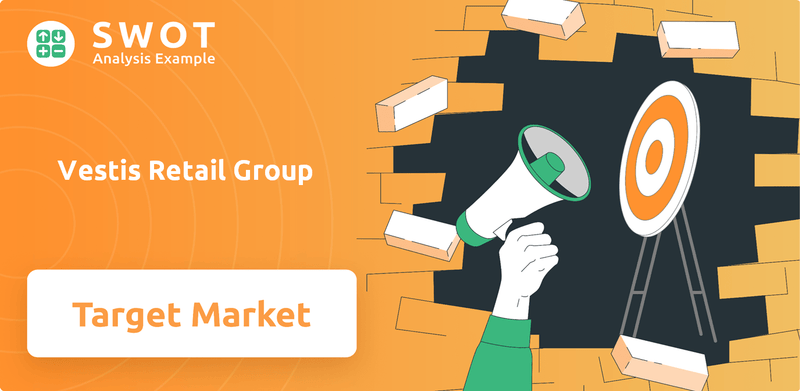
This exploration into Vestis Retail Group's Target market analysis will illuminate the company's attempts to understand its Retail customer profile. We will examine the customer's age range, income levels, preferred shopping channels, and buying habits. By dissecting these elements, we aim to reveal the challenges and strategic missteps that ultimately led to its restructuring. This deep dive into Market segmentation and consumer behavior offers valuable lessons for any business navigating a changing landscape.
Who Are Vestis Retail Group’s Main Customers?
Prior to its bankruptcy, Vestis Retail Group, formerly operating under various banners, catered to a diverse customer base. A thorough understanding of its customer demographics and target market is crucial for analyzing its market position and challenges. The company's retail strategy was built around three distinct brands, each with a specific customer focus within the active lifestyle and outdoor equipment sectors.
Analyzing the customer demographics helps in understanding the company's market segmentation strategies. This analysis includes factors like age, income, lifestyle, and shopping preferences. This segmentation is vital for tailoring marketing efforts and product offerings to meet the specific needs of each customer group. A detailed market research report would offer insights into the ideal customer persona for each brand.
Understanding the customer buying habits is key to assessing the company's performance. This involves looking at what products were most popular, how often customers made purchases, and the preferred shopping channels. This information is crucial for evaluating the customer churn rate analysis and customer lifetime value. The company's ability to adapt to changing consumer behavior, including the rise of online retail, significantly impacted its success.
EMS primarily targeted serious outdoor enthusiasts and adventurers. This segment typically comprised individuals aged 25-55, with higher income levels, and a strong interest in activities such as hiking, camping, climbing, and skiing. These customers prioritized quality and specialized features in their gear. Understanding the customer lifestyle analysis of this group is essential.
Bob's Stores focused on a more value-conscious, family-oriented demographic. Their customers often included parents and individuals looking for everyday apparel, footwear, and workwear, with a focus on affordability and practicality. This segment spanned a broader age range, typically 18-65+, and represented a more diverse income spectrum. The company's market segmentation strategies were key to success.
Sport Chalet primarily served athletes and active individuals interested in team sports, fitness, and outdoor recreation. Their customer base often included younger demographics, from teenagers to young adults, as well as families participating in various sports. This segment valued performance-oriented products and brand recognition. Analyzing the customer interests and hobbies was vital.
Over time, Vestis Retail Group faced challenges in adapting to shifts in consumer preferences. The increasing dominance of online retail and direct-to-consumer brands significantly impacted the company. These shifts ultimately proved difficult to navigate, leading to its eventual restructuring and liquidation. The company's inability to adapt to these changes is a key factor.
The failure of Vestis Retail Group underscores the importance of understanding customer demographics and adapting to market changes. The company's struggles highlight the need for businesses to remain agile and responsive to evolving consumer preferences. A deep dive into the Revenue Streams & Business Model of Vestis Retail Group can provide additional context.
- The core issue was the inability to compete with online retailers.
- Each brand needed to understand its customer's preferred shopping channels.
- The company's target market analysis was not sufficient to address changing consumer needs.
- Understanding the customer buying habits and the customer lifetime value was crucial.
Vestis Retail Group SWOT Analysis
- Complete SWOT Breakdown
- Fully Customizable
- Editable in Excel & Word
- Professional Formatting
- Investor-Ready Format
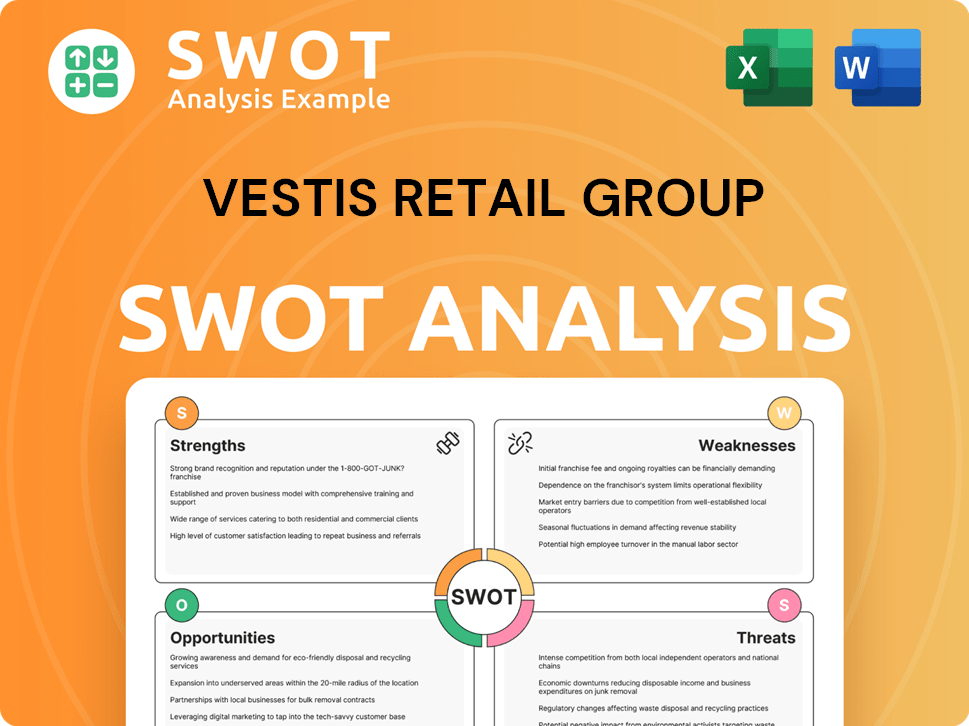
What Do Vestis Retail Group’s Customers Want?
Understanding the customer needs and preferences is crucial for effective retail strategies. For Owners & Shareholders of Vestis Retail Group, this involved recognizing the diverse needs of its customer base across different retail banners. This analysis provides insights into the customer demographics, target market analysis, and consumer behavior that shaped the company's approach.
The customer needs varied significantly across the different retail banners operated by Vestis Retail Group. Each brand catered to a distinct segment, with unique preferences and purchasing behaviors. This segmentation allowed the company to tailor its offerings and marketing efforts to resonate with specific customer groups, impacting the overall retail customer profile.
Analyzing these segments is vital for understanding market segmentation within Vestis Retail Group. By examining the motivations, purchasing criteria, and loyalty factors for each customer group, the company could refine its strategies to meet the evolving demands of the retail landscape. This approach is essential for making informed decisions about product development, marketing campaigns, and overall business operations.
EMS customers prioritized performance, reliability, and specialized functionality. They were outdoor enthusiasts seeking gear for activities like mountaineering and backpacking. Their purchasing decisions were often influenced by detailed product research and brand reputation.
Bob's Stores customers were primarily motivated by value, practicality, and convenience. They sought affordable apparel and footwear for everyday use. Their decisions were often based on price points and the availability of a wide range of sizes.
Sport Chalet's clientele prioritized performance, brand recognition, and the latest trends. Their motivations were often tied to improving athletic performance and maintaining an active lifestyle. They sought products that offered a competitive edge.
Common pain points included the desire for competitive pricing and a seamless shopping experience. Vestis Retail Group aimed to address these through various initiatives, adapting to the rapidly evolving retail landscape and intense competition.
Loyalty factors varied. For EMS, it was expertise and community. Bob's Stores saw loyalty through consistent value and promotions. Sport Chalet customers valued brand recognition and the latest trends.
Psychological drivers for EMS included aspirational goals and a connection with nature, while practical drivers focused on safety and comfort. Bob's Stores customers focused on immediate needs at a reasonable cost.
Understanding the customer demographics, including factors like age range, income levels, and preferred shopping channels, is essential for effective market segmentation. Analyzing customer buying habits, lifestyles, and interests provides further insights. This helps in defining the ideal customer persona and developing customer segmentation strategies. The challenges include adapting to fast-changing market trends, which is crucial for addressing customer churn rate and maximizing customer lifetime value. Recent data indicates that customer preferences are increasingly influenced by online shopping, with a significant shift towards mobile commerce. For example, in 2024, mobile commerce accounted for approximately 40% of all e-commerce sales, highlighting the importance of a seamless online experience. Furthermore, the ability to offer competitive pricing and personalized recommendations has become increasingly important in retaining customers. According to a 2024 study, businesses that personalize customer experiences see a 10-15% increase in revenue.
- Adapt to changing market trends.
- Focus on competitive pricing.
- Ensure a seamless shopping experience.
- Provide access to knowledgeable staff.
Vestis Retail Group PESTLE Analysis
- Covers All 6 PESTLE Categories
- No Research Needed – Save Hours of Work
- Built by Experts, Trusted by Consultants
- Instant Download, Ready to Use
- 100% Editable, Fully Customizable
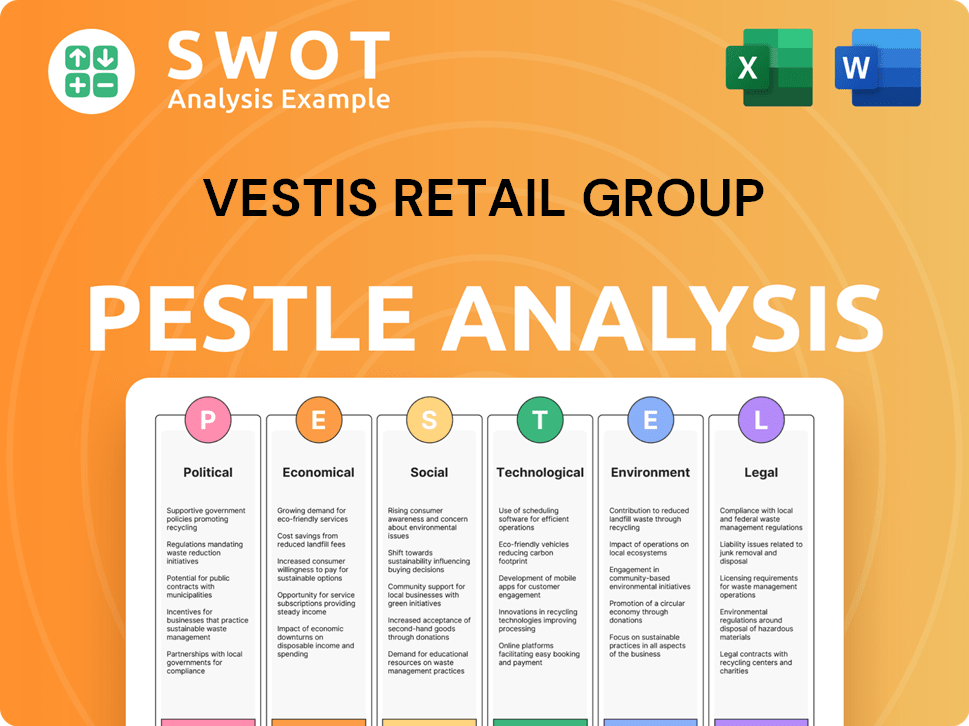
Where does Vestis Retail Group operate?
The geographical market presence of Vestis Retail Group, which included brands like Eastern Mountain Sports (EMS), Bob's Stores, and Sport Chalet, was primarily concentrated in the Eastern and Western United States. This strategic distribution was a key factor in how the company approached its customer demographics and overall target market analysis. The regional focus allowed each brand to cater to specific consumer preferences and lifestyle needs.
EMS, with its focus on outdoor gear, had a strong presence in the Northeast, particularly in states like Massachusetts, New York, and Vermont. Bob's Stores, known for value-oriented apparel, thrived in the Northeast and Mid-Atlantic regions, including Connecticut and New Jersey. Sport Chalet dominated the Western United States, especially California, capitalizing on the active lifestyle culture there.
The company's geographical strategy aimed to leverage the unique characteristics of each region. However, the diverse regional market dynamics and competition from national chains and online retailers presented significant challenges. The company's eventual bankruptcy in 2016 highlights the difficulties in sustaining a widespread geographical presence with varying regional demands.
EMS stores were strategically located near popular outdoor recreation areas in the Northeast. This positioning helped attract customers interested in outdoor activities. The brand recognition within the outdoor community was strong, particularly among those with higher disposable incomes.
Bob's Stores focused on the Northeast and Mid-Atlantic states, where it had built a loyal customer base. The brand catered to a market seeking value-oriented apparel and footwear. These markets were characterized by a dense population and strong demand for affordable clothing.
Sport Chalet's operations were primarily in the Western United States, especially California. California's large population and active lifestyle culture were key factors. The brand held strong recognition in various Californian cities.
Differences in customer demographics and buying power were evident across regions. EMS customers often had higher disposable incomes, while Bob's Stores catered to a broader customer base. The company faced challenges in effectively catering to these nuanced regional demands.
Vestis Retail Group utilized market segmentation strategies to target different customer groups based on their location and preferences. This approach aimed to tailor product offerings and marketing efforts to meet regional demands. Understanding the retail customer profile was crucial for effective segmentation.
Consumer behavior varied across regions, influencing buying habits. For example, customers in the Northeast might show different preferences compared to those in the West. Analyzing customer buying habits was essential for optimizing product placement and marketing campaigns.
The competitive landscape included national chains and online retailers. These competitors exerted pressure on Vestis Retail Group's market share. Understanding the competitors target market was vital for developing effective strategies.
The company's strategic withdrawals and eventual bankruptcy in 2016 underscore the difficulties in sustaining a widespread geographical presence. These challenges highlighted the need for a deeper understanding of Vestis Retail Group customer churn rate analysis and Vestis Retail Group customer lifetime value.
Conducting thorough market research report was crucial for understanding regional differences. This included analyzing Vestis Retail Group customer age range, Vestis Retail Group target audience location, and Vestis Retail Group income levels of customers. Such insights would inform decisions about product offerings and marketing.
Creating an ideal customer persona for each brand would help tailor marketing efforts. This involved analyzing Vestis Retail Group customer interests and hobbies. Understanding the Vestis Retail Group customer demographics by product category was also essential.
Vestis Retail Group Business Model Canvas
- Complete 9-Block Business Model Canvas
- Effortlessly Communicate Your Business Strategy
- Investor-Ready BMC Format
- 100% Editable and Customizable
- Clear and Structured Layout
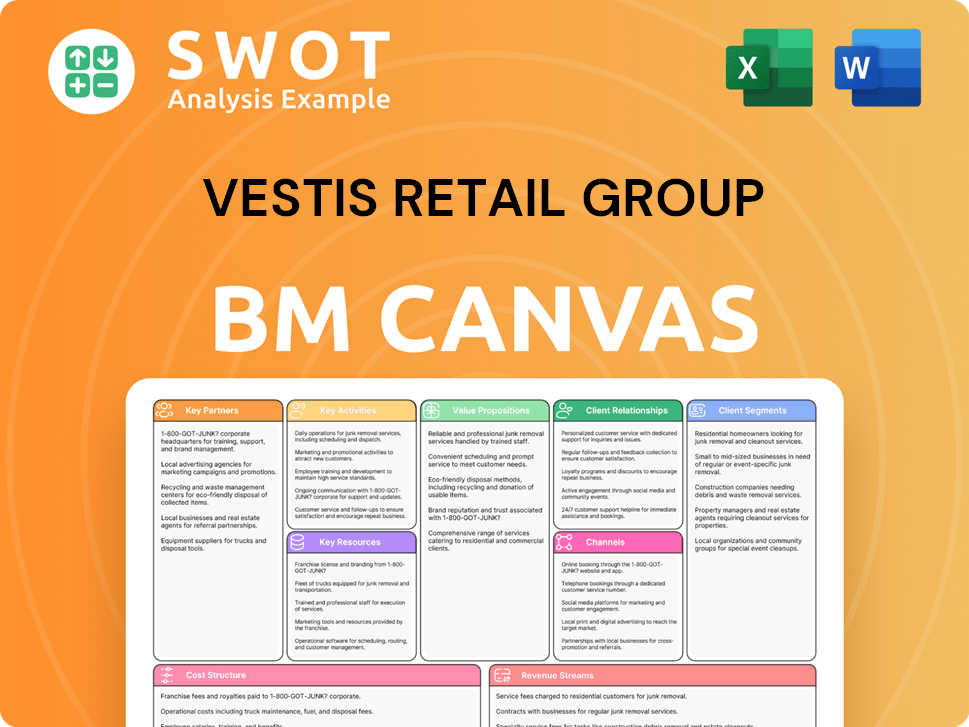
How Does Vestis Retail Group Win & Keep Customers?
Before its bankruptcy, Vestis Retail Group, encompassing Eastern Mountain Sports (EMS), Bob's Stores, and Sport Chalet, employed a blend of traditional and emerging digital strategies to acquire and retain customers. These tactics were crucial in a competitive retail environment. Understanding the customer demographics and target market was essential for effective marketing and sales.
The company's approach to customer acquisition leaned heavily on traditional marketing methods. Print ads in local newspapers and outdoor magazines, radio spots, and direct mail campaigns were common. In-store promotions and seasonal sales events also played a significant role in attracting customers. As digital marketing gained traction, email campaigns and search engine marketing (SEM) were introduced.
Customer retention efforts included loyalty programs, offering discounts and exclusive access. The company also focused on personalized in-store service, especially at EMS, and after-sales support. However, the rapid shift to e-commerce and increased competition posed challenges, affecting customer loyalty and contributing to higher churn rates before its 2016 liquidation.
Traditional marketing was a cornerstone of Vestis Retail Group's customer acquisition strategy. This included print advertisements in local newspapers and outdoor magazines. Radio spots and direct mail campaigns were also widely used. In-store promotions and seasonal sales events were key to driving foot traffic, especially during peak shopping seasons.
- Print Ads: Utilized in local newspapers and outdoor magazines to reach specific demographics.
- Radio Spots: Broadcasted to target local audiences and promote special offers.
- Direct Mail: Sent promotional materials and catalogs to potential customers.
- In-Store Promotions: Offered discounts and special deals to attract immediate sales.
Email marketing was used to promote deals and new arrivals. Targeted email campaigns helped to keep customers informed about the latest products and promotions. This strategy aimed to drive repeat purchases and increase customer engagement.
SEM and display advertising were employed to reach broader online audiences. These digital marketing techniques helped to increase brand visibility and drive traffic to the company's websites. This approach was crucial for competing in the growing e-commerce market.
Partnerships with local sports leagues, outdoor clubs, and community events were leveraged to build brand awareness. This was particularly effective for Sport Chalet and EMS, attracting targeted customer segments interested in outdoor activities and sports. These partnerships helped to build brand loyalty.
Customer retention strategies included loyalty programs that offered discounts and exclusive access to sales. These programs were designed to incentivize repeat business and foster customer loyalty. The effectiveness of these programs varied across the different banners.
Personalized experiences were attempted through in-store customer service, where knowledgeable staff offered tailored advice. EMS, in particular, emphasized expert associates to provide specialized product recommendations. This approach aimed to build strong customer relationships.
After-sales service, such as product warranties and return policies, played a role in building customer trust and loyalty. Providing reliable after-sales support was essential for maintaining customer satisfaction. This approach helped to reduce churn rates.
The rapid shift in retail towards e-commerce and the increasing competition from online retailers posed significant challenges. These shifts impacted customer loyalty and lifetime value. The inability to adapt quickly to these changes contributed to increased churn rates. For example, the e-commerce market grew by 14.8% in 2023, highlighting the pressure on traditional retailers. Furthermore, the average customer churn rate in the retail sector was approximately 30% in 2024, emphasizing the need for robust retention strategies. To understand the broader picture, consider a deep dive into Growth Strategy of Vestis Retail Group.
- E-commerce Growth: The rise of online shopping forced traditional retailers to compete with digital platforms.
- Increased Competition: Competition from online retailers and large national chains intensified.
- Customer Loyalty: The ability to retain customers became more challenging due to increased options.
- Churn Rates: The rate at which customers stopped doing business increased, impacting profitability.
Vestis Retail Group Porter's Five Forces Analysis
- Covers All 5 Competitive Forces in Detail
- Structured for Consultants, Students, and Founders
- 100% Editable in Microsoft Word & Excel
- Instant Digital Download – Use Immediately
- Compatible with Mac & PC – Fully Unlocked
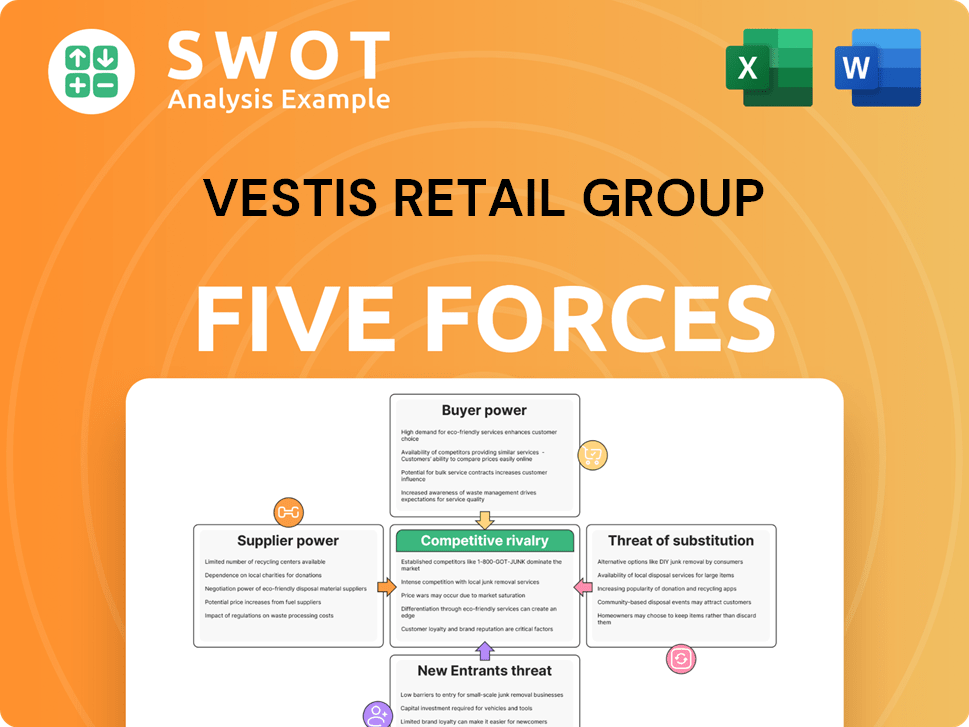
Related Blogs
- What are Mission Vision & Core Values of Vestis Retail Group Company?
- What is Competitive Landscape of Vestis Retail Group Company?
- What is Growth Strategy and Future Prospects of Vestis Retail Group Company?
- How Does Vestis Retail Group Company Work?
- What is Sales and Marketing Strategy of Vestis Retail Group Company?
- What is Brief History of Vestis Retail Group Company?
- Who Owns Vestis Retail Group Company?
Disclaimer
All information, articles, and product details provided on this website are for general informational and educational purposes only. We do not claim any ownership over, nor do we intend to infringe upon, any trademarks, copyrights, logos, brand names, or other intellectual property mentioned or depicted on this site. Such intellectual property remains the property of its respective owners, and any references here are made solely for identification or informational purposes, without implying any affiliation, endorsement, or partnership.
We make no representations or warranties, express or implied, regarding the accuracy, completeness, or suitability of any content or products presented. Nothing on this website should be construed as legal, tax, investment, financial, medical, or other professional advice. In addition, no part of this site—including articles or product references—constitutes a solicitation, recommendation, endorsement, advertisement, or offer to buy or sell any securities, franchises, or other financial instruments, particularly in jurisdictions where such activity would be unlawful.
All content is of a general nature and may not address the specific circumstances of any individual or entity. It is not a substitute for professional advice or services. Any actions you take based on the information provided here are strictly at your own risk. You accept full responsibility for any decisions or outcomes arising from your use of this website and agree to release us from any liability in connection with your use of, or reliance upon, the content or products found herein.